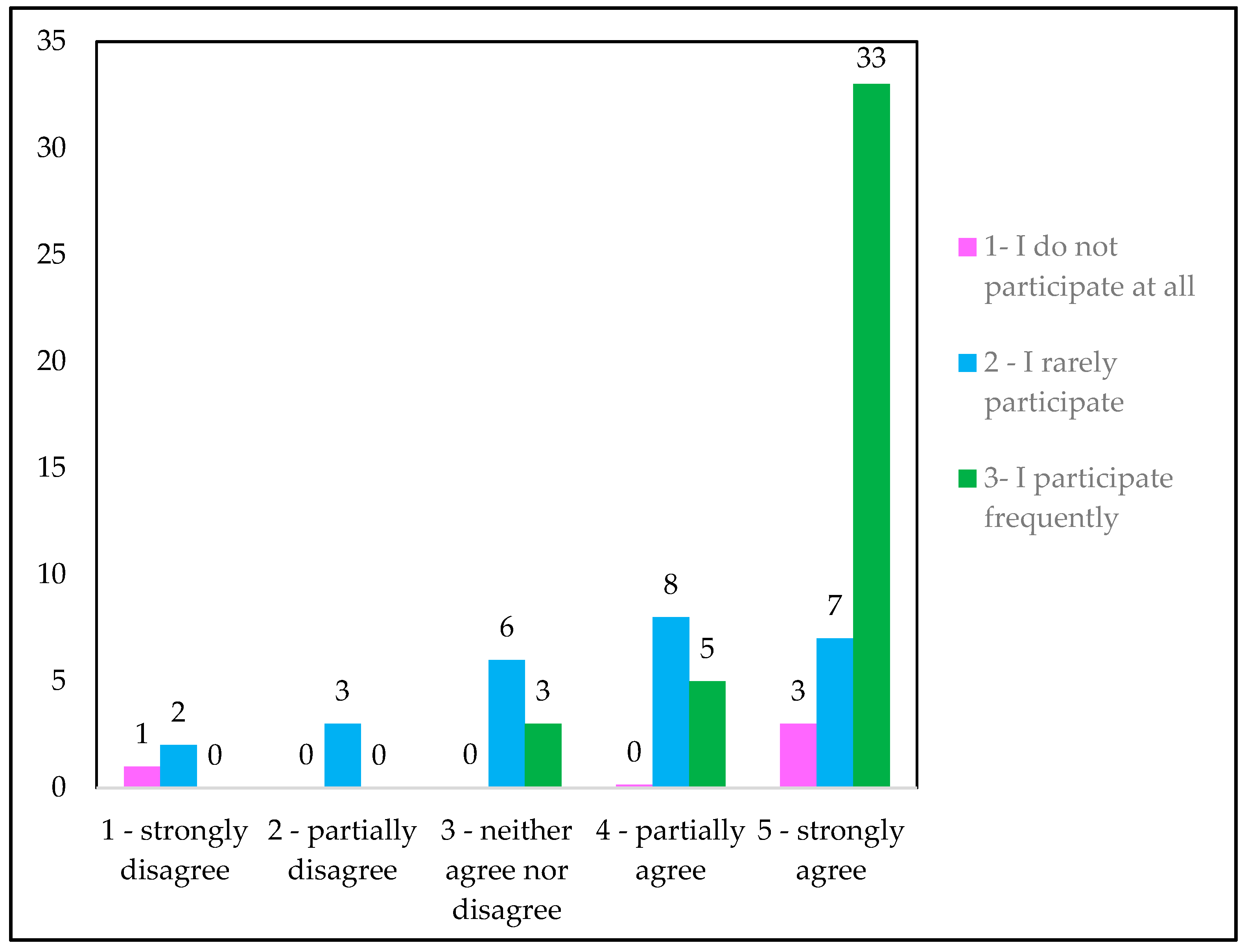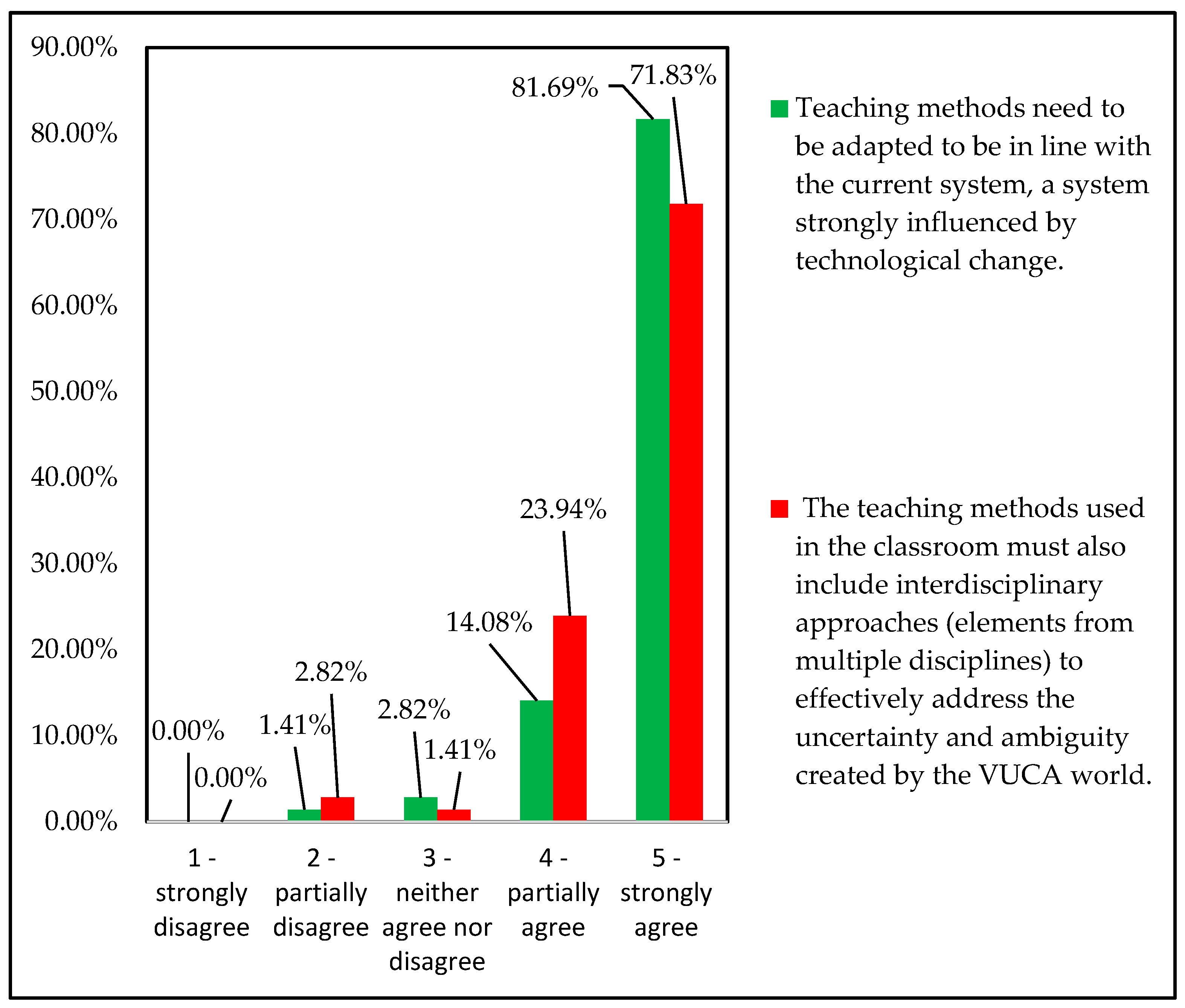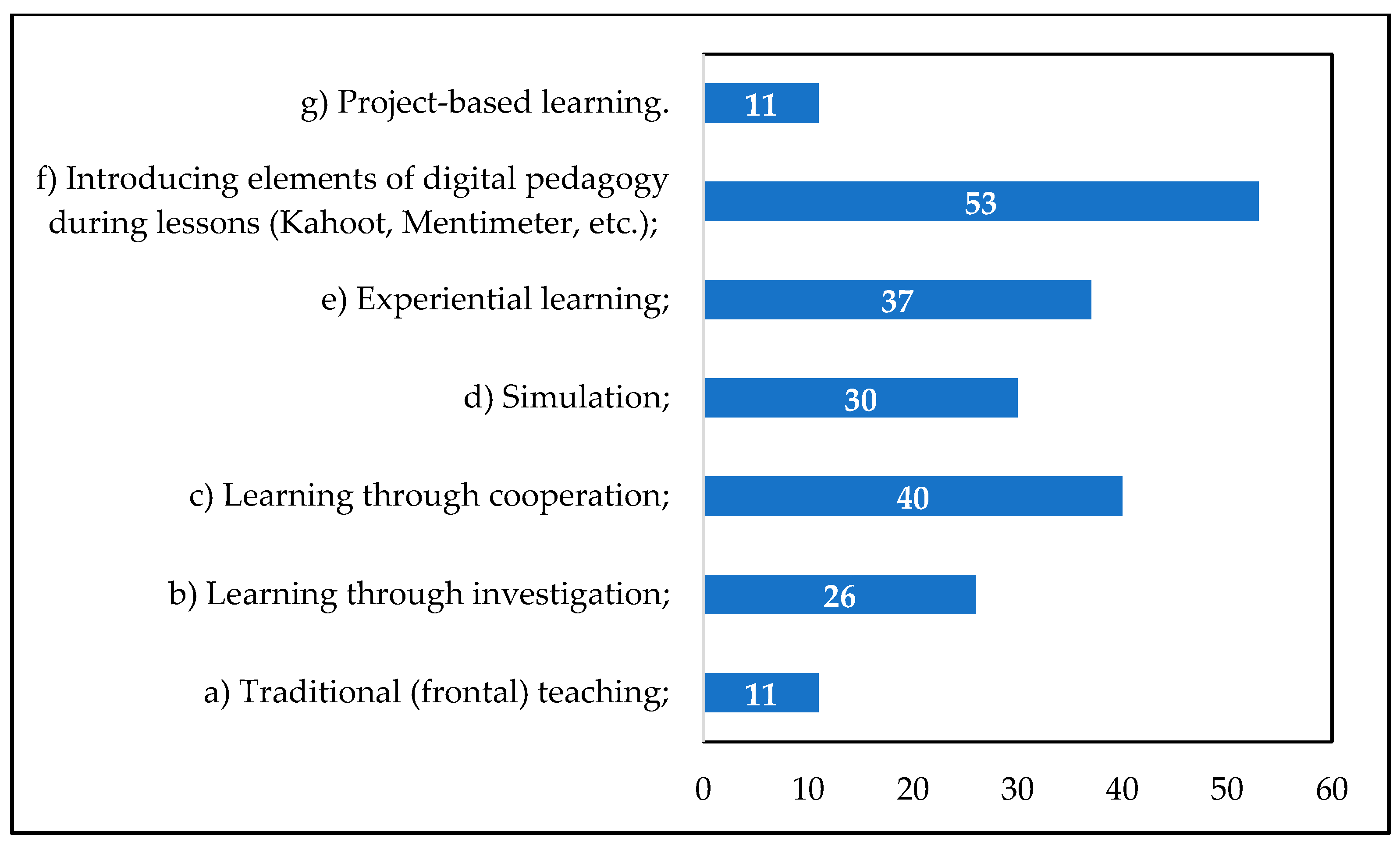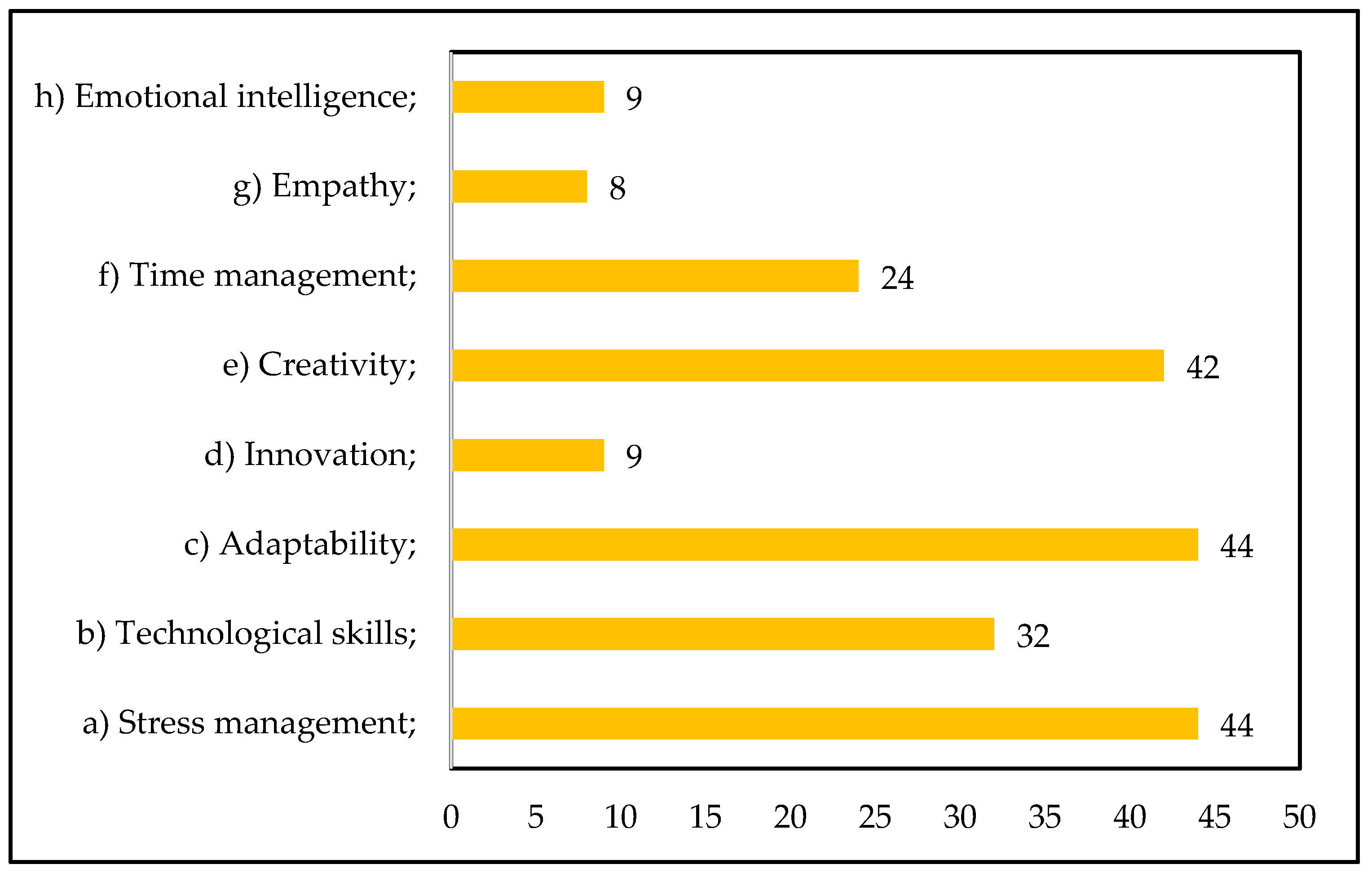The Challenges of the VUCA World and the Education System: The Need for Change to Ensure Sustainable Learning Process
Abstract
1. Introduction
2. Literature Review
3. Materials and Methods
3.1. Method
3.2. Participants
3.3. Hypothesis
4. Results and Discussion
5. Limitations and Further Research
6. Conclusions
6.1. Final Conclusions
6.2. Practical Implications for Educators
Author Contributions
Funding
Institutional Review Board Statement
Informed Consent Statement
Data Availability Statement
Conflicts of Interest
References
- Bennett, N.; Lemoine, J. What VUCA really means for you. Harv. Bus. Rev. 2014, 92, 27. [Google Scholar]
- Kautish, P.; Hameed, S.; Kour, P.; Walia, S. Career beliefs, self-efficacy and VUCA skills: A study among generation Z female students of tourism and hospitality. J. Hosp. Leis. Sport Tour. Educ. 2022, 30, 100340. [Google Scholar] [CrossRef]
- Abdelzaher, D.; Onumonu, M. Building synergistic mindsets in international business education: The unmet demands of a VUCA marketplace. In Critical Perspectives on International Business; Emerald Publishing: Leeds, UK, 2024; pp. 1–24. [Google Scholar]
- Mielkov, I. Higher education under the conditions of complexity and uncertainty of the world. Post-Non-Classical Development Strategies and Personal Dimension. Int. Sci. J. Univ. Leadersh. 2020, 9, 62–77. [Google Scholar] [CrossRef]
- Waller, R.; Lemoine, P.; Mense, E.; Garretson, C.; Richardson, M. Covid-19’s uncomfortable revelations about agile and sustainable organizations in a VUCA world. J. Appl. Behav. Sci. 2019, 56, 279–283. [Google Scholar]
- Randolph, W. Developing global business capabilities in MBA students. J. Manag. Inq. 2011, 20, 223–240. [Google Scholar] [CrossRef]
- Besonia, B. Teachers’ knowledge, perceptions, and practices in integrating elements of volatility, uncertainty, complexity, and ambiguity (VUCA) into language teaching. Int. J. Adv. Appl. Sci. 2024, 11, 19–30. [Google Scholar] [CrossRef]
- Bühler, M.; Jelinek, T.; Nübel, K. Training and preparing tomorrow’s workforce for the fourth industrial revolution. Educ. Sci. 2022, 12, 782. [Google Scholar] [CrossRef]
- Rossouw, D.; Goldman, G. Technology and collaboration as strategic drivers shaping higher education. J. Transdiscipl. Res. S. Afr. 2023, 19, 1–10. [Google Scholar] [CrossRef]
- Ab Jalil, H.; Ismail, I.; Ma’rof, A.; Lim, C.; Hassan, N.; Che Nawi, N. Predicting Learners’ Agility and Readiness for Future Learning Ecosystem. Educ. Sci. 2020, 12, 680. [Google Scholar] [CrossRef]
- Bogdanova, M.; Parashkevova-Velikova, E. Agile Perspectives in Higher Education. In Education, Research and Business Technologies; Springer: Berlin/Heidelberg, Germany, 2022. [Google Scholar]
- Saeed, I.; Khan, J.; Zada, M.; Ullah, R.; Vega-Muñoz, A.; Contreras-Barraza, N. Towards examining the link between workplace spirituality and workforce agility: Exploring higher educational institutions. Psychol. Res. Behav. Manag. 2022, 15, 31–49. [Google Scholar] [CrossRef] [PubMed]
- Latha, S.; Prabu, C. Vuca in Engineering Education: Enhancement of Faculty Competency For Capacity Building. Procedia Comput. Sci. 2020, 172, 741–747. [Google Scholar] [CrossRef]
- Arar, K.; Zohri, A.-A.; Zohri, A.-A.; Alhouti, I.; Chaaban, Y.; Sawalhi, R.; Salha, S. A critical analysis of education policy in turbulent times: A comparative study. Power Educ. 2023, 16, 117–138. [Google Scholar] [CrossRef]
- Jinga, I. Bazele Managementului Educational; ASE: Bucharest, Romania, 2009. [Google Scholar]
- Baran, B.; Woznyj, H. Managing VUCA: The human dynamics of agility. Organ. Dyn. 2021, 50, 100787. [Google Scholar] [CrossRef] [PubMed]
- Bennett, N.; Lemoine, J. What a difference a word makes: Understanding threats to performance in a VUCA world. Bus. Horiz. 2014, 57, 311–317. [Google Scholar] [CrossRef]
- Kaivo-Oja, J.R.L.; Lauraeus, I.T. The VUCA approach as a solution concept to corporate foresight challenges and global technological disruption. Foresight 2018, 20, 27–49. [Google Scholar] [CrossRef]
- Saleh, A.; Watson, R. Business excellence in a volatile, uncertain, complex and ambiguous environment (BEVUCA). TQM J. 2017, 29, 705–724. [Google Scholar] [CrossRef]
- Sarkar, A. We live in a VUCA World: The importance of responsible leadership. Dev. Learn. Organ. 2016, 30, 9–12. [Google Scholar] [CrossRef]
- Laukkonen, R.E.; Biddel, H.; Gallagher, R. Preparing Humanity for Change and Artificial Intelligence: Learning to Learn as a Safeguard against Volatility, Uncertainty, Complexity, and Ambiguity; OECD Publishing: Paris, France, 2019. [Google Scholar]
- Guo, Y.; Zhao, Q.; Cao, Z.; Huang, S. The influence of tourism and hospitality students’ perceived effectiveness of outcome-based education on their VUCA skills. Sci. Rep. 2023, 13, 8079. [Google Scholar] [CrossRef] [PubMed]
- Hadar, L.; Ergas, O.; Alpert, B.; Ariav, T. Rethinking teacher education in a VUCA world: Student teachers’ social-emotional competencies during the Covid-19 crisis. Eur. J. Teach. Educ. 2020, 43, 573–586. [Google Scholar] [CrossRef]
- Yaccob, N.; Yunus, M.; John, D. Global education movement: English as a second language teachers’ perceptions of integrating volatility, uncertainty, complexity, and ambiguity elements in lessons. Front. Psychol. 2023, 14, 1–9. [Google Scholar] [CrossRef] [PubMed]
- Vuksanović Herceg, I.; Kuč, V.; Mijušković, V.; Herceg, T. Challenges and Driving Forces for Industry 4.0 Implementation. Sustainability 2020, 12, 4208. [Google Scholar] [CrossRef]
- Ferreira, C.; Cardoso, C.; Travassos, M.; Paiva, M.; Pestana, M.; Lopes, J.; Oliveira, M. Disorders, Vulnerabilities and Resilience in the Supply Chain in Pandemic Times. Logistics 2021, 5, 48. [Google Scholar] [CrossRef]
- Meyer, A.; Walter, W.; Seuring, S. The Impact of the Coronavirus Pandemic on Supply Chains and Their Sustainability: A Text Mining Approach. Front. Sustain. 2021, 2, 631182. [Google Scholar] [CrossRef]
- Sombultawee, K.; Lenuwat, P.; Aleenajitpong, N.; Boon-itt, S. COVID-19 and Supply Chain Management: A Review with Bibliometric. Sustainability 2022, 14, 3538. [Google Scholar] [CrossRef]
- Qadir, J.; Al-Fuqaha, A. A Student Primer on How to Thrive in Engineering Education during and beyond COVID-19. Educ. Sci. 2020, 10, 236. [Google Scholar] [CrossRef]
- Zadorina, O.; Burchak, L.; Panas, O.; Ardelian, O.; Apalat, H. Shaping the competencies of the future: The importance of developing soft skills in higher education. Cad. Educ. Tecnol. Soc. 2023, 16, 361–371. [Google Scholar] [CrossRef]
- Kusumastuti, I.; Fauziati, E.; Marmanto, S. Revealing teachers’ beliefs of higher order thinking skills in teaching reading at junior high school. In Proceedings of the 3rd English Language and Literature International Conference, ELLiC, Semarang, Indonesia, 27 April 2019; The European Alliance for Innovation (EAI): Gent, Belgium, 2019; Volume 3, pp. 155–162. [Google Scholar]
- Gunawardena, M.; Sooriyampola, M.; Walisundara, N. Scaffolding thinking in ESL lessons: Negotiating challenges. Think. Ski. Creat. 2017, 24, 279–285. [Google Scholar] [CrossRef]
- Chai, C.S.; Kong, S. Professional learning for 21st century education. J. Comput. Educ. 2017, 4, 1–4. [Google Scholar] [CrossRef]
- Joita, E. Management Educational; Polirom: Iași, Romania, 2000. [Google Scholar]
- Cerghit, I. Metode de Invatamant; Polirom: Bucharest, Romania, 2006. [Google Scholar]
- Ciobanu, O. Elemente de Teoria si Metodologia Instruirii: Prelegeri Universitare; ASE: Bucharest, Romania, 2003. [Google Scholar]
- Bag, S. Developing agile, digital, resilient and sustainable suppliers’ dynamic capability for enhanced supply chain quality: A qualitative study. TQM J. 2025. [Google Scholar] [CrossRef]
- Timotheou, S.; Miliou, O.; Dimitriadis, Y.; Sobrino, S.; Giannoutsou, N.; Cachia, R.; Ioannou, A. Impacts of digital technologies on education and factors influencing schools’ digital capacity and transformation: A literature review. Educ. Inf. Technol. 2023, 28, 6695–6726. [Google Scholar] [CrossRef] [PubMed]
- Henriksen, D.; Creely, E.; Gruber, N.; Leahy, S. Social-Emotional Learning and Generative AI: A Critical Literature Review and Framework for Teacher Education. J. Teach. Educ. 2025, 76, 312–328. [Google Scholar] [CrossRef]
- Fu, B.; Hadid, A.; Damer, N. Generative AI in the context of assistive technologies: Trends, limitations and future directions. Image Vis. Comput. 2025, 154, 105347. [Google Scholar] [CrossRef]
- Miao, F.; Holmes, W. Guidance for Generative AI in Education and Research; UNESCO: Paris, France, 2023; Available online: https://unesdoc.unesco.org/ark:/48223/pf0000386693 (accessed on 3 December 2024).
- Aldosari, S. The future of higher education in the light of artificial intelligence transformations. Int. J. High. Educ. 2020, 9, 145–151. [Google Scholar] [CrossRef]
- Mulyani, H.; Istiaq, M.A.; Shauki, E.R.; Kurniati, F.; Arlinda, H. Transforming education: Exploring the influence of generative AI on teaching performance. Cogent Educ. 2025, 12, 2448066. [Google Scholar] [CrossRef]
- Holmes, W.; Bialik, M.; Fadel, C. Artificial Intelligence in Education: Promises and Implications for Teaching and Learning; The Center for Curriculum Redesign: Boston, MA, USA, 2019. [Google Scholar]
- Minciu, M. Educational Management Approaches in the Context of the VUCA World. Ph.D. Thesis, Bucharest University of Economic Studies, Bucharest, Romania, 2025. [Google Scholar]
- Imrith, M.K.; Rosunee, S.; Unmar, R. Engineering UPF and comfort parameters of knitted fabrics and validation using statistical techniques. Res. J. Text. Appar. 2023, 27, 306–328. [Google Scholar] [CrossRef]
- Kolmogorov, A. On the empirical determination of a distribution law. J. Ital. Inst. Actuar. 1993, 4, 83–91. [Google Scholar]
- Shapiro, S.; Wilk, M. An analysis of variance test for normality (complete samples). Biometrika 1965, 52, 591–611. [Google Scholar] [CrossRef]
- Vasile, A.S. Statistica Psihologica si Prelucrarea Informatizata a Datelor; Pro Universitaria: Bucharest, Romania, 2016. [Google Scholar]
- Caena, F.; Redecker, C. Aligning teacher competence frameworks to 21st century challenges: The case for the European digital competence framework for educators (DIGCOMPEDU). Eur. J. Educ. 2019, 54, 356–369. [Google Scholar] [CrossRef]
- Gamage, K.; Pradeep, R.; De Silva, E. Rethinking Assessment: The Future of Examinations in Higher Education. Sustainability 2022, 14, 3552. [Google Scholar] [CrossRef]
- Wuthisatian, R. Student exam performance in different proctored environments: Evidence from an online economics course. Int. Rev. Econ. Educ. 2020, 35, 100196. [Google Scholar] [CrossRef]
- Milone, A.; Cortese, A.; Balestrieri, R.; Pittenger, A. The impact of proctored online exams on the educational experience. Curr. Pharm. Teach. Learn. 2017, 9, 108–114. [Google Scholar] [CrossRef] [PubMed]
- Williams, J.; Wong, A. The efficacy of final examinations: A comparative study of closed-book, invigilated exams and open-book, open-web exams. Br. J. Educ. Technol. 2009, 40, 227–236. [Google Scholar] [CrossRef]
- Joga, F. A Study of the Requirements for Online Teaching and Learning in Romanian Schools. In Proceedings of the International Conference on Business Excellence, Bucharest, Romania, 23–25 March 2023; Sciendo: Bucharest, Romania, 2023; Volume 17, pp. 2132–2138. [Google Scholar]
- Ferri, F.; Grifoni, P.; Guzzo, T. Online Learning and Emergency Remote Teaching: Opportunities and Challenges in Emergency Situations. Societies 2020, 10, 86. [Google Scholar] [CrossRef]
- Bennis, W.; Nanus, B. Leaders: The Strategies for Taking Charge; Harper & Row: New York, NY, USA, 1985. [Google Scholar]
- Rožman, M.; Oreški, D.; Tominc, P. Artificial-Intelligence-Supported Reduction of Employees’ Workload to Increase the Company’s Performance in Today’s VUCA Environment. Sustainability 2023, 15, 5019. [Google Scholar] [CrossRef]
- Presbitero, A.; Teng-Calleja, M. Job attitudes and career behaviors relating to employees’ perceived incorporation of artificial intelligence in the workplace: A career self-management perspective. Pers. Rev. 2023, 52, 1169–1187. [Google Scholar] [CrossRef]
- Malik, N.; Tripathi, S.; Kar, A.; Gupta, S. Impact of artificial intelligence on employees working in industry 4.0 led organizations. Int. J. Manpow. 2022, 43, 334–354. [Google Scholar] [CrossRef]
- Marin, E. Experiential learning: Empowering students to take control of their learning by engaging them in an interactive course simulation environment. Procedia Soc. Behav. Sci. 2015, 180, 854–859. [Google Scholar] [CrossRef]
- Association for Experiential Education. Experiential Education. 2025. Available online: https://www.aee.org/ (accessed on 3 December 2024).
- Rahiman, H.; Kodikal, R. Revolutionizing education: Artificial intelligence empowered learning in higher education. Cogent Educ. 2024, 11, 1–24. [Google Scholar] [CrossRef]
- Narot, P.; Kiettikunwong, N. The Advent of Assistive Technology and Instructions for Restructuring Schools for Special Education Need Students. Int. Perspect. Incl. Educ. 2023, 20, 247–258. [Google Scholar]





| The Educational Paradigm in the 21st Century | The Educational Paradigm in the 20th Century |
|---|---|
| Non-linear learning | Linear instruction system |
| The teacher is the mentor, coordinator of activities, and organizer of the learning and information environment | The teacher is a “transmitter” of information |
| Flexible class composition | Permanent, rigorous class composition |
| Information sources are unlimited | Limited sources of information |
| Broad educational and information environment (created by both teacher and pupils) | Educational and information environment prepared exclusively by the teacher |
| Pupils’ cognitive, autonomous stance | Pupil’s position: receives information prepared by teachers |
| Educational content transmitted is comprehensive, integrating concepts from several subjects | The educational content transmitted is the same as in textbooks and school curricula, with only insignificant new elements added |
| The Roles of Teacher |
|---|
| Intervene frequently at all stages of the lesson in order to maintain an interactive framework; |
| Structure the content of the lesson in such a way that the activities carried out lead to the achievement of the operational objectives previously set; |
| Involve pupils in solving tasks and encourage them to work collaboratively with other children to solve certain case studies/team projects; |
| Use a variety of assessment methods to ensure objectivity, check pupils’ answers and solutions; |
| Positively influence pupils’ motivation and participation in lessons through teaching strategies and methods; |
| Demonstrate adaptability and flexibility by using new teaching methods and elements of digital pedagogy; |
| Be a promoter of lifelong learning, demonstrating that improvement and education never stop. |
| Faculty | Number of Students | Percentage |
|---|---|---|
| The Faculty of Business Administration (in Foreign Languages) | 8 | 11.27% |
| The Faculty of Administration and Public Management | 5 | 7.04% |
| The Faculty of Business and Tourism | 2 | 2.82% |
| The Faculty of Economic Cybernetics, Statistics and Informatics | 18 | 25.35% |
| The Faculty of Accounting and Management Information Systems | 9 | 12.68% |
| The Faculty of Agrifood and Environmental Economics | 2 | 2.82% |
| The Faculty of Theoretical and Applied Economics | 4 | 5.63% |
| The Faculty of Finance and Banking | 5 | 7.04% |
| The Faculty of Management | 7 | 9.85% |
| The Faculty of Marketing | 2 | 2.82% |
| The Faculty of International Business and Economics | 9 | 12.68% |
| Total | 71 | 100% |
| Frequency_of_Participation | Kolmogorov–Smirnov a | Shapiro–Wilk | |||||
|---|---|---|---|---|---|---|---|
| Statistic | df | Sig. | Statistic | df | Sig. | ||
| Educational_environmental_volatility | 2 | 0.20 | 30 | 0.00 | 0.85 | 30 | 0.00 |
| 3 | 0.47 | 41 | 0.00 | 0.50 | 41 | 0.00 | |
| Ranks | ||||
|---|---|---|---|---|
| Frequency_of_participation | N | Mean Rank | Sum of Ranks | |
| Educational_environmental_volatility | 2 | 30 | 25.43 | 736.00 |
| 3 | 41 | 43.73 | 1793.00 | |
| Total | 71 | |||
| Test Statistics a | |
|---|---|
| Educational_environmental_volatility | |
| Mann–Whitney U | 298.00 |
| Wilcoxon W | 763.00 |
| Z | −4.20 |
| Asymp. Sig. (2-tailed) | 0.00 |
Disclaimer/Publisher’s Note: The statements, opinions and data contained in all publications are solely those of the individual author(s) and contributor(s) and not of MDPI and/or the editor(s). MDPI and/or the editor(s) disclaim responsibility for any injury to people or property resulting from any ideas, methods, instructions or products referred to in the content. |
© 2025 by the authors. Licensee MDPI, Basel, Switzerland. This article is an open access article distributed under the terms and conditions of the Creative Commons Attribution (CC BY) license (https://creativecommons.org/licenses/by/4.0/).
Share and Cite
Minciu, M.; Veith, C.; Dobrea, R.C.; Ciocoiu, C.N. The Challenges of the VUCA World and the Education System: The Need for Change to Ensure Sustainable Learning Process. Sustainability 2025, 17, 6600. https://doi.org/10.3390/su17146600
Minciu M, Veith C, Dobrea RC, Ciocoiu CN. The Challenges of the VUCA World and the Education System: The Need for Change to Ensure Sustainable Learning Process. Sustainability. 2025; 17(14):6600. https://doi.org/10.3390/su17146600
Chicago/Turabian StyleMinciu, Mihaela, Cristina Veith, Razvan Catalin Dobrea, and Carmen Nadia Ciocoiu. 2025. "The Challenges of the VUCA World and the Education System: The Need for Change to Ensure Sustainable Learning Process" Sustainability 17, no. 14: 6600. https://doi.org/10.3390/su17146600
APA StyleMinciu, M., Veith, C., Dobrea, R. C., & Ciocoiu, C. N. (2025). The Challenges of the VUCA World and the Education System: The Need for Change to Ensure Sustainable Learning Process. Sustainability, 17(14), 6600. https://doi.org/10.3390/su17146600







